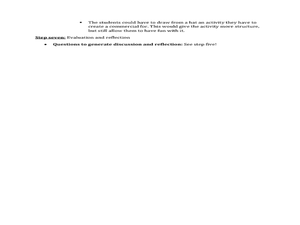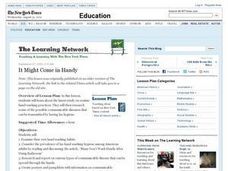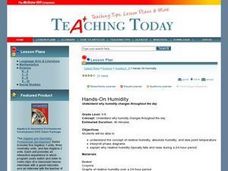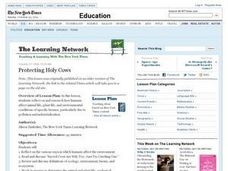Curated OER
Breezy, Chilly, or Freezing?
Students assess the factors which influence the sensation of being "cold" in a particular situation. They study the complexities in measuring temperature by reading and discussing the article "Beyond Brrr: The Elusive Science of...
Curated OER
Ben Franklin's Inventions
Students discover the life of Benjamin Franklin by studying his inventions. In this biography lesson, students identify the inventions of Benjamin Franklin and their impact on society today. Students create a commercial in an...
Curated OER
Build an Approximate Scale Model of an Object
Young scholars create a model of an object of their choice using sketches that they have drawn. They study what a scale model is and how to construct one. They examine the uses for scale models and why they are produced.
Curated OER
Biomes: Land of the Inuit
Students study Inuit and their ancestors. In this biomes lesson students study the relationship between the Inuit and their environment and create a class art gallery.
Scholastic
Prescription Pain Medications
Students study different pain medications and their side effects. For this drug usage lesson students read articles and complete a worksheet.
Curated OER
Disease and Epidemics
High schoolers watch a video to introduce the study of historical outbreaks of infectious diseases and epidemics. They create charts of diseases after reading an article and share their information as a class.
Curated OER
Integrating Science and Literature: Life as We Knew It
Supplement your science units with science fiction novels!
Curated OER
It Might Come in Handy
Students explore the latest study on routine hand washing practices. They research some of the possible communicable diseases that can be transmitted by having lax hygiene.
Curated OER
TE Lesson: What's Dominant?
Students study the number of chromosomes in the body cells, sperm cells, and egg cells of humans. They define allele, and examine the difference between dominant and recessive alleles. They complete an activity with jelly beans that...
Curated OER
Koala Bear Exhibit
Students visit the zoo and study the koala bears. For this habitat lesson, students take a field trip to the zoo and examine the habitat of the koala bears. Students watch videos about koalas and consider the needs of the koalas....
Curated OER
Pieces of the Past
Students study the importance of preserving the archaeological record. They write a paragraph describing an object and why it is important to them. They cut their paper into a puzzle and compare their own to the student they trade with.
Curated OER
The Extinction of Dinosaurs
Students study the life and death of the dinosaur by building dioramas. In this dinosaur lesson, students research the extinct creatures, then build dinosaur dioramas. Afterward, the students engage in a discussion about the extinction...
Curated OER
Bioethics: Tool for Portfolio and Performance Assessment
Students, in cooperative studying groups, assume the affirmative or negative position of a particular issue (premise). They research the issue and participate in a debate. In addition, they write essays to complete a portfolio entry.
Curated OER
Wetland Food Webs
Students study life science. In this food webs and food chains comparison instructional activity, students examine the wetlands to discover the relationships that exist between the animals that live there. They participate in group...
Curated OER
State Change
Eighth graders explore the physical change of matter. As a class, they discuss their favorite super hero and determine if the hero undergoes a physical or chemical change. Students examine the change of state and phase change. In groups,...
Curated OER
Hands-On Humidity
Young scholars examine why humidity changes throughout the day. They study the concept of relative humidity, absolute humidity, and dew point temperature. They interpret phase diagrams and explain why relative humidity typically falls...
Curated OER
Invertebrate Chordates
Most chordates are easy to identify because of the specific classification criteria of their phylum. But what about tunicates? Young scientists read a short explanation about why tunicates, or sea squirts, are considered to be members of...
Curated OER
Comparison of Normal vs Mutant Zebra Fish Embryos
Students observe and study mutations. In this mutations lesson, students work in groups to complete observation tables of various mutations of the zebra fish embryos. Groups give presentations about their observations.
Curated OER
Cyclones
Students explore Earth science by researching natural disasters in class. In this cyclone lesson, students discuss the creation of cyclones and what their potential destruction can be in the wrong environment. Students read assigned text...
Curated OER
Environmental Limitations
Seventh graders study the environmental factors that affect population growth. For this biology lesson, 7th graders create a city following certain criteria. They present their posters in class.
Curated OER
Protecting Holy Cows
Students study the interrelationships of organisms and their environments. They study ecological communities and determine what is necessary for survival. Students discuss and answer questions concerning a group's biome, habitat, food...
Curated OER
Seed Dispersion of Strawberries and Dandelions
Students investigate how seeds are dispersed on land. In this plant biology lesson, students use a dissecting microscope to study strawberry seeds and dandelion seeds, they draw what they see, then create a hypothesis on the seeds...
Curated OER
An Explorative Journey Through the Solar System
Students explore space science by creating a planetary model in class. In this solar system lesson, students identify the many planets and moons that make up the solar system and decide on one entity in which to research. Students create...
Curated OER
Food Chains and Food Webs
Fourth graders study intertidal organisms and their role in the food web. In this food web lesson, 4th graders read the book The Sea That Feeds Us and discuss food webs. Students study pictures of intertidal creatures and discuss their...























